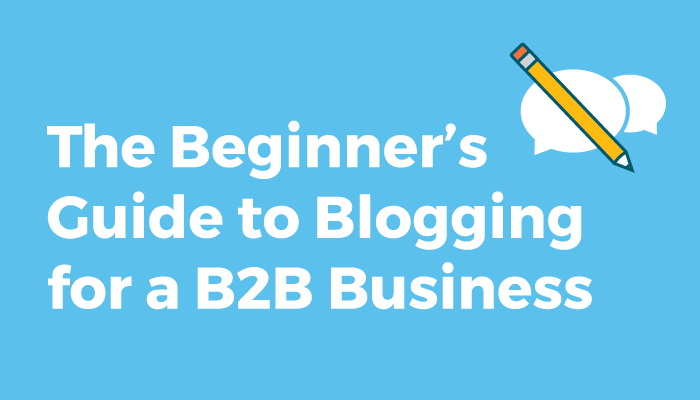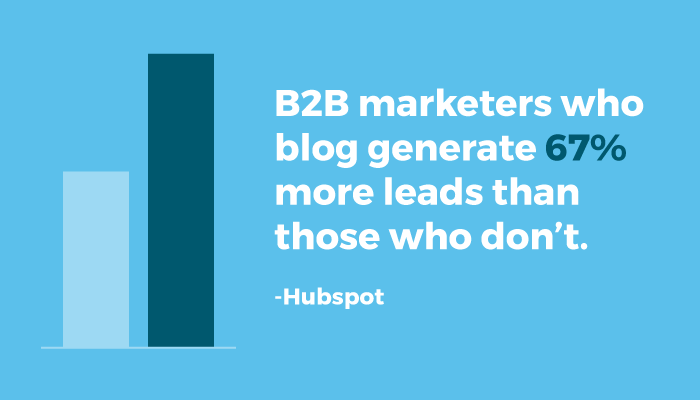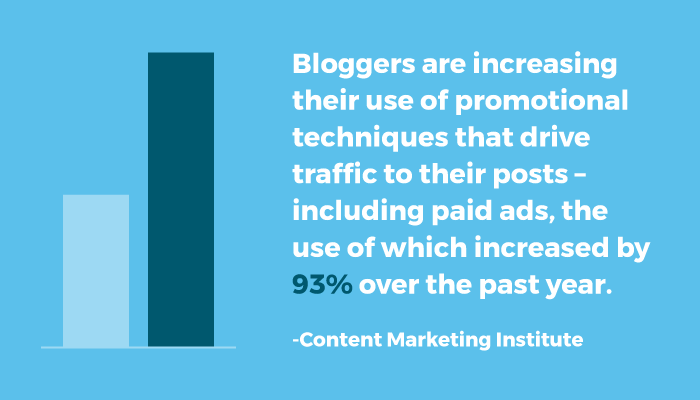The Beginner’s Guide to Blogging for a B2B Business

Let’s state the obvious, there are many different kinds of bloggers. But today we’re going to split them into two—personal bloggers and business bloggers. Personal bloggers write under their own name and brand about topics that interest them—some to make a living and some as a hobby.
Business bloggers, on the other hand, are writers or marketers employed by a company to create blog content for different purposes—to drive sales, increase brand awareness, and so on. The purpose of making this distinction is to highlight the difference between how these two types of bloggers operate.
While the Blog Herald generally covers topics intended for personal bloggers, we recognize that there’s likely some overlap between these two groups. Meaning—there are many personal bloggers who are also employed by larger companies.
Today, we’re speaking to all you marketers and business bloggers out there. If you’ve ever wanted to know how to write for a business, or even how to take your businesses blog to the next level, keep reading!
Blogging for a B2B Business
In a world where content is still king, businesses who blog are achieving the most success. In fact, 37% of marketers say blogs are the most valuable type of content marketing. Here’s why—if executed correctly, consistent blogging can have an enormous impact on your ability to reach your marketing goals. Think lead generation, brand awareness, search engine optimization, customer relationships, and of course revenue.
Consider these statistics:
- B2B marketers who blog generate 67% more leads than those that do not.
- 69% of businesses attribute their lead generation success to blogging.
- 57% of companies with a blog have acquired a customer from their blog.
- Marketers who prioritize blogging are 13x more likely to achieve a positive ROI on their efforts.
A successful blog is a powerful tool to have in your B2B marketing toolbox. But, creating a blog that drives real results isn’t just something you can throw together. To reap the many benefits of blogging, you must have a well-formed strategy in place.
So, if you’d like to do more with your B2B blog, keep reading! Today we give you the beginner’s guide to B2B blogging.
Section One: Plan Ahead
Let’s start from scratch. This section covers the steps you need to take to prime your blog for success.
1. Define your objectives.
Establish a clear set of goals for your blogging initiatives. Typically, these will be in line with your overall marketing goals. Truly consider what you’re trying to achieve. Is your focus on brand awareness? Customer support? Lead generation?
Clear goals not only give you direction, but they’re also necessary later on when it comes time to evaluate your progress.
2. Identify your target audience.
Before you begin to blog, you must know who your audience is. It sounds simple. Of course, you know who your audience is, right? But a general idea isn’t good enough. In order to be successful, you need to get granular.
Start by developing detailed profiles of your ideal customers—or what we refer to as buyer personas. Buyer personas are created using demographic and firmographic data such as job title, job function, management level, industry, and company size. More importantly, buyer personas tell you who you should write for, what they’re interested in, and much, much more.
In its most basic form, a buyer persona looks something like this: A 25-35-year-old male, working in sales at a company with 250+ employees, that produces $1 million a year in revenue. A more sophisticated buyer persona goes beyond surface-level details to include factors such as shared pain points, common opinions, and similar buying habits.
Buyer personas provide you with a deep understanding of your target audience, which can inform nearly every aspect of your blog strategy, including the topic, timing, and tone of voice that suits your readership best.
For an in-depth guide to buyer persona creation, check out the following article: The Beginner’s Guide to Buyer Personas.
3. Establish an editorial calendar.
Consistency is key to a successful B2B blog. Even if your content is top-notch, chances are your readers won’t return for more if you don’t publish at regular intervals. An editorial calendar will hold your team accountable and help to keep them organized. As a result, you’ll provide your readers the consistency they crave.
To get the most out of your editorial calendar, plan it out in advance – even if that means simply scheduling out ideas! This will at least give you an indication of what’s to come. Not to mention, the more ideas you build up, the less likely you are to suffer from the dreaded writers’ block.
Obviously, effective blogging is often a time-consuming project. For B2B bloggers just starting out, we suggest you take it slow. Don’t bite off more than you can chew! Start with one or two posts a week.
Section Two: Consider Your Content
Now that the logistics and planning portion is out of the way, it’s time to get strategic about your content. To put it simply, the content you provide is paramount to the success of your blog. Think about it: It’s what your readers came for! If they don’t like what they find, they’re never going to return.
While there is no such thing as the perfect content strategy, here are the key characteristics of high-quality content that you should always keep in mind:
1. Value
Many B2B companies find that blogs perform best as top of the funnel content. By this we mean—content meant to attract the attention of readers who may not be familiar with your brand or content. The goal is to turn them into loyal visitors who eventually become paying customers.
That said, try to avoid overly promotional content. Instead, focus your efforts on creating posts that engage, inform and entertain your readers. Whatever you choose to write about, make sure it is meaningful to your target audience.
2. Relevance
Don’t select post topics at random; instead, stick to what you know! Hone in on your niche, and focus on topics that are relevant to your readers, your brand and your industry. Having said that, we don’t mean you should constantly write about the same things. Instead, consider what topics run parallel to your brand.
For example, a company that sells an HR violation tracker doesn’t have to write only about HR violations. They should cover things like team building, workplace negativity, or performance appraisals. Each of these topics is of interest to an audience who is qualified to purchase their product.
3. Lasting Power
Ask yourself, is my content evergreen? Like the tree it’s named after, evergreen content stands the test of time. Content that is evergreen will make sense for years to come. This type of content reduces post expiration and will make each of your blog posts a valuable resource regardless of how recent it was posted.
4. Originality
It’s never a good idea to copy. According to a recent study, 62% of people feel good about a company that delivers custom content. Original content not only sets you apart from the crowd but also positions your brand as an industry thought leader.
5. Authenticity
Readers are quick to pick up on authenticity. Skip the robotic tone and opt for a more informal approach. Don’t be afraid to infuse your personality into your content. Conversational language, relevant humor, and even anecdotal details can transform dull subject matter into captivating content.
6. Actionable
Your content should never be a dead end. Include actionable steps and clear calls-to-action. This will keep prospects engaged with your brand even if they’re not quite ready to buy. We don’t just mean asking your readers to fill out a free trial form. Truly consider how to write a piece of content that visitors can take and apply to their day-to-day lives. If your posts don’t inspire or teach your readers to do something, you’re not giving them a reason to return.
7. Interesting
This seems like a no-brainer but we’re still going to say it: Your content must be interesting. Everything from the body of your post to the images you use to your headline should capture the reader’s attention and keep them engaged.
8. Readability
Blog readers prefer a specific type of content format; they are not in the market for a novel. They want a post that provides them with a lot of value, for a little effort. In fact, 43% of people admit to skimming blog posts.
Because of this, be sure to format your posts to allow for easy scanning. Consider using headings, subheadings and bulleted lists to break up the text and make it easier to digest. People are generally looking for something in a blog post—make it easy for readers to pick out pertinent information.
Section Three: Build Your Readership
Once you’ve got your content situated, it’s time to generate traffic to your blog. Because the internet is so saturated with content, you can’t rely on visitors stumbling upon your blog. In fact, Bloggers are increasing their use of promotional techniques that drive traffic to their posts – including paid ads, the use of which increased by 93% over the past year.
If you’re not interested in paying for readers, here are a few other marketing channels and tools to consider:
- Social media: For many bloggers and businesses, social media is the outlet of choice to promote blog content. To garner the most return, be sure to use short, engaging taglines and eye-catching images to make your content more clickable.
- Content syndication: Content syndication is the process of repurposing or re-publishing your posts on other websites and digital platforms. This process amplifies the reach and engagement of your content by leveraging the audiences of complementary brands and platforms.
- Email marketing: Set up a way for readers to subscribe to your blog. Whether through an RSS feed or a weekly email update, giving readers a way to stay connected is imperative. With so many blogs saturating the marketplace, it’s difficult to get someone to read a blog post—let alone return for more. Capture their contact information and use it to keep them engaged.
To learn more about marketing your blog, check out this article: Why Marketing Your Blog is Crucial to Its Success.
Section Four: Commit to the Process
Unfortunately, a successful blog isn’t created overnight – it takes time, a lot of effort, and a heavy dose of persistence. To see your initiative ignite, you must commit yourself to the process. Think of your blog as an ongoing program – not a campaign. The more time, energy and thought you devote to your blog, the happier you will be with the end result.
Contributed by Krysta Williams, Marketing Content Specialist at ZoomInfo. ZoomInfo offers the most accurate and actionable B2B data to help organizations accelerate growth and profitability. The continuously updated corporate contact database enables sales and marketing teams to execute more effective marketing campaigns and improve sales prospecting efforts.




